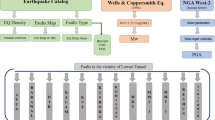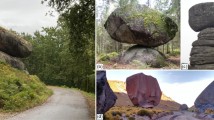Abstract
Earthquake fault ruptures may emerge at the ground surface causing large differential movements. When fault ruptures emerge at or adjacent to the position of existing foundations, significant damage can be caused. However, the study of recent faulting events revealed that in some circumstances the fault-rupture emergence is deflected by the presence of buildings leaving the buildings intact. A centrifuge modelling study has been conducted to investigate how normal faults interact with strip foundations which run parallel to the strike direction. The study confirms that fault rupture may be deviated by the presence of the foundation so that the foundation is protected from the most serious differential movements. However, whilst the fault propagates to the soil surface the foundation has to withstand initial movements before the final fault rupture emergence mechanism is activated. The centrifuge results suggest that it is the bearing pressure of the foundation which causes the deviation of the fault rather than the kinematic restraint of the foundation. The interaction between the earthquake fault and the shallow foundation depends on the foundation bearing pressure, foundation width, soil depth and position of the fault relative to the foundation and these aspects should be considered in design. Results from the tests are used to validate a series of finite element analyses as reported in an accompanying paper.
Similar content being viewed by others
References
Anastasopoulos I, Gazetas G (2007a) Foundation-structure systems over a rupturing normal fault: I. Obser- vations after the Kocaeli 1999 Earthquake. Bull Earthquake Eng 5(3): 253–275 doi:10.1007/s10518-007-9029-2
Anastasopoulos I, Gazetas G (2007b) Behaviour of structure-foundation systems over a rupturing normal fault: II Analyses, experiments, and the Kocaeli case histories. Bull Earthquake Eng 5(3): 277–301 doi:10.1007/s10518-007-9030-9
Anastasopoulos I, Callerio A, Bransby MF, Davies MCR, Gazetas G, Masella A et al (2008) Numerical analyses of fault–foundation interaction. Bull Earthquake Eng (submitted)
Berill JB (1983) Two-dimensional analysis of the effect of fault rupture on buildings with shallow foundations. Soil Dyn Earthquake Eng 2(3): 156–160 doi:10.1016/0261-7277(83)90012-8
Bolton MD (1986) The strength and dilatancy of sands. Geotechnique 36(1): 65–78
Bray JD (1990) The effects of tectonic movements on stresses and deformations in earth embankments. Ph.D. Dissertation, University of California, Berkeley
Bray JD (2001) Developing mitigation measures for the hazards associated with earthquake surface fault rupture. In A workshop on seismic fault-induced failures—possible remedies for damage to urban facilities. Japan Society for the promotion of science, University of Tokyo, Japan, January 11–12, pp 55–79
Bray JD, Seed RB, Cluff LS, Seed HB (1994) Earthquake fault rupture propagation through soil. J Geotech Eng, ASCE 120(3): 543–561
Cole DA Jr, Lade PV (1984) Influence zones in alluvium over dip-slip faults. J Geotech Eng 110: 599–615
Faccioli E, Anastasopoulos I, Callerio A, Gazetas G (2008) Case histories of fault–foundation interaction. Bull Earthquake Eng (submitted)
Gaudin C (2002) Modélisation physique et numérique des écrans de soutènement: application à l’étude de l’effet d’une surcharge sur le sol soutenu. PhD. thesis, Université de Nantes.
Lade PV, Cole DA, Cummings D (1984) Multiple failure surfaces over dip-slip faults. J Geotech Eng 110(5): 616–627
Lazarte CA, Bray JD (1996) A study of strike-slip faulting using small-scale models. Geotech Test J, Am Soc Test Mater 19(2): 118–129
Lazarte CA (1996) The response of earth structures to surface fault rupture. Ph.D. Thesis, Department of Civil Engineering, University of California, Berkeley
Muhlhaus HB, Vardoulakis L (1987) The thickness of shear bands in granular materials. Geotechnique 37(3): 271–283
Muir Wood D, Stone KJL (1994) Some observations of zones of localisation in model tests on dry sand. In: Chambon R, Desrues J, Vardoulakis I(eds) Localisation and bifurcation theory for soils and rocks. A.A. Balkema, Rotterdam, pp 155–164
Muir Wood D (2002) Some observations of volumetric instabilities in soils. Int J Solids Struct 39: 3429–3449
Muir Wood D (2004) Geotechnical modelling. Spon Press, London
Niccum MR, Cluff LS, Chamoro F, Wylie L (1976) Banco Central de Nicaragua: a case history of a high-rise building that survived surface fault rupture. In Humphrey CB (ed) Engineering Geology and Soils Engineering Symposium, No. 14. Idaho Transportation Department, Division of Highways, pp 133–144
O’Rourke MJ (2003) Buried pipelines. In: Chen W-F, Scawthorn C (eds) Earthquake engineering handbook. CRC Press, Boca Raton
Pamuk A, Kalkanb E, Linga HI (2005) Structural and geotechnical impacts of surface rupture on 468 highway structures during recent earthquakes in Turkey. Soil Dyn Earthquake Eng 25: 581–589 doi:10.1016/j.soildyn.2004.11.011
Pecker A, Faccioli E, Gazetas G, Paolucci R (2008), Design recommendations for fault–foundation interaction. Bull Earthquake Eng (submitted)
Roth WH, Scott RF, Austin I (1981) Centrifuge modelling of fault propagation through alluvial soils. Geophys Res Lett 8(6): 561–564 doi:10.1029/GL008i006p00561
Roth WH, Sweet J, Goodman RE (1982) Numerical and physical modelling of flexural slip phenomena and potential for fault movement. Rock Mech (Suppl. 12):27–46
Scarpelli G, Wood DM (1982) Experimental observations of shear band patterns in direct shear. In: Vermeer PA, Luger HJ(eds) Proceedings of the IUTAM symposium on deformation and failure of granular materials. Balkema, Rotterdam, pp 473–484
Schofield AN (1980) Cambridge University geotechnical centrifuge operations. Rankine lecture. Geotechnique 30(3): 227–268
Scott RF, Schoustra JJ (1974) Nuclear power plant siting on deep alluvium. J Geotech Eng Div ASCE 100(4): 449–459
Stone KJL, Muir Wood D (1992) Effects of dilatancy and particle size observed in model tests on sand. Soils Found 32(4): 43–57
Ulusay R, Aydan O, Hamada M (2002) The behaviour of structures built on active fault zones: examples from the recent earthquakes of Turkey. Struct Eng Earthquake Eng, JSCE 19(2): 149–167
Vardoulakis I, Graf B, Gudehus G (1981) Trap-door problem with dry sand: a statical approach based on model test kinematics. Int J Numer Anal Methods Geomech 5: 58–78 doi:10.1002/nag.1610050106
White RJ, Stone KJL, Jewel RJ (1994), Effect of particle size on localization development in model tests on sand. In: Leung, Lee, Tan (eds) Centrifuge 94. Balkema, Rotterdam, pp 817–822
White DJ, Take WA, Bolton MD (2003) Soil deformation measurement using particle image velocimetry (PIV) and photogrammetry. Geotechnique 53(7): 619–631 doi:10.1680/geot.53.7.619.37383
Yilmaz MT, Paolucci R (2006) Earthquake fault rupture–shallow foundation interaction in undrained soils: a simplified analytical approach. Earthquake Eng Struct Dyn 36(1): 101–118
Author information
Authors and Affiliations
Corresponding author
Rights and permissions
About this article
Cite this article
Bransby, M.F., Davies, M.C.R. & Nahas, A.E. Centrifuge modelling of normal fault–foundation interaction. Bull Earthquake Eng 6, 585–605 (2008). https://doi.org/10.1007/s10518-008-9079-0
Received:
Accepted:
Published:
Issue Date:
DOI: https://doi.org/10.1007/s10518-008-9079-0




